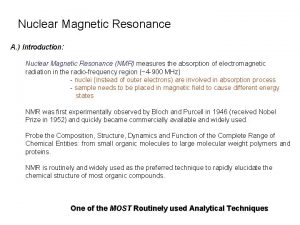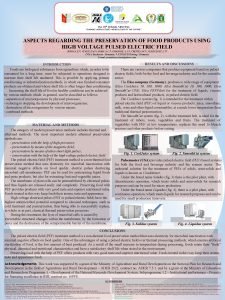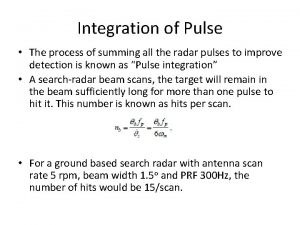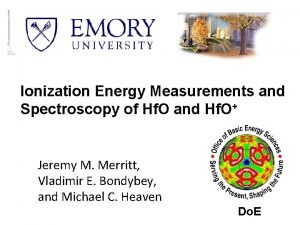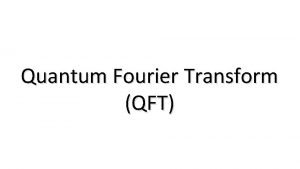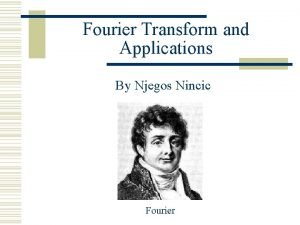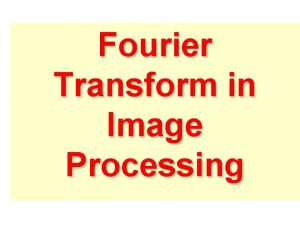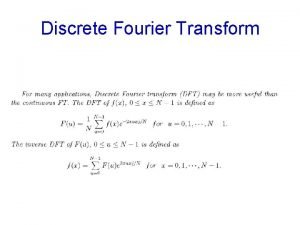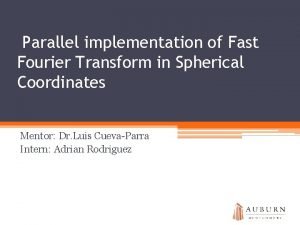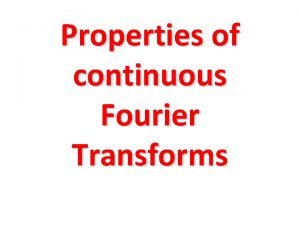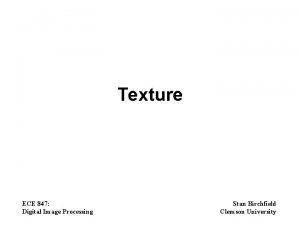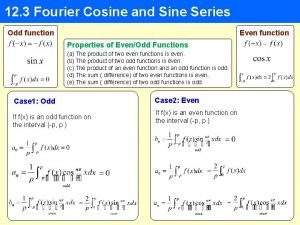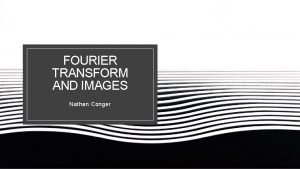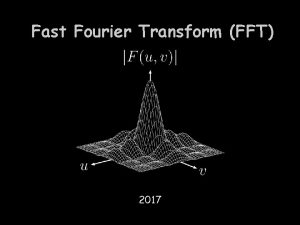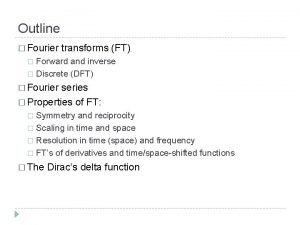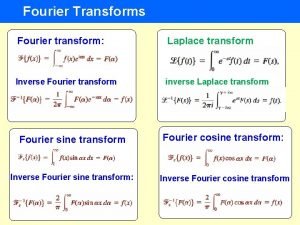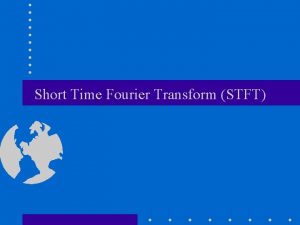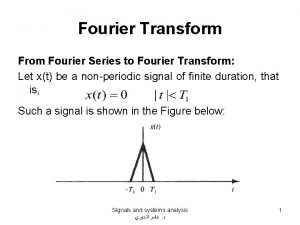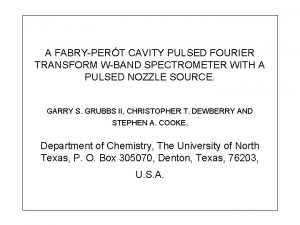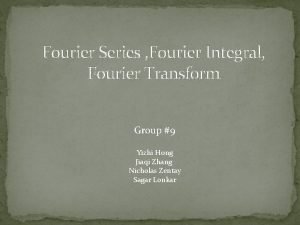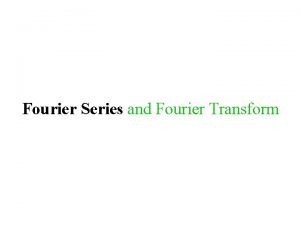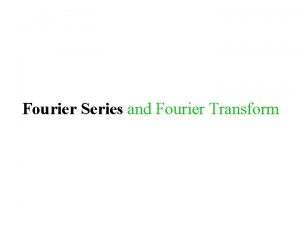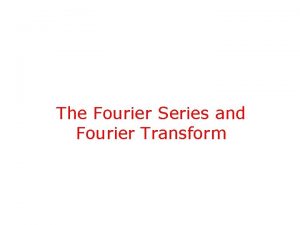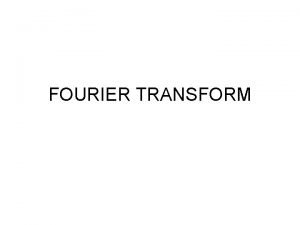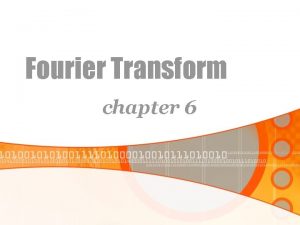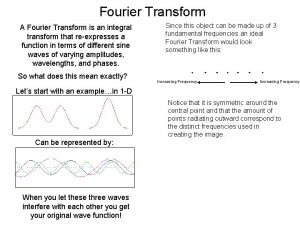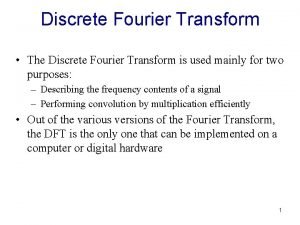NMR Instrumentation Modern Pulsed Fourier Transform NMR Spectrometer














- Slides: 14

NMR Instrumentation Modern Pulsed Fourier Transform NMR Spectrometer Why? with superconducting magnet Superconducting Magnet Computer Electronics Console 1

Chem 3204: NMR Instrumentation Components of a NMR spectrometer: • An intense, homogeneous and stable magnetic field (magnet + shim) • A “probe” which enables the coils used to excite and detect the signal to be placed close to the sample • High-power RF transmitter/s capable of delivering short pulses source +receiver RF Amplifier) • (RF A sensitive to amplify the NMR signals (RF Detector) • A Digitizer to convert the NMR signals into a form which can be stored in computer memory • A “pulse programmer” to produce precisely timed pulses and delays • A computer to control everything and to process the data 2

Superconducting Magnet (SCM): A Big Stainless Steel Dewar • use persistent superconducting magnets to generate the B 0 field; • at low temperatures (less than 6 K, typically) the resistance goes to zero – that is the wire(eg. Nb alloy) is superconducting; • To maintain the wire in its superconducting state the coil is immersed in a bath of liquid helium (4 K, expensive); • “heat shield” kept at 77 K by contact with a bath of liquid nitrogen (cheap) to reduces the amount of liquid helium boils off; • vacuum flask so as to further reduce the Advantages of SCM ? heat flow. 1. Strongest Magnet; 2. Stable & homogeneous magnet field Bo; 3 3. Low running cost.

Sensitivity & Price Sensitivity B 0 3/2 $ USD 7 - 9. 4 - 11. 7 - 14 - 18. 7 - 21 Tesla 300 - 400 - 500 - 600 - 800 - 900 MHz 4

Shim Coils • High resolution NMR requires linewidths of 1 Hz or less • Magnetic field across the sample must be homogeneous so that the corresponding variation in the Larmor frequency is small • Surround the sample with a set of shim coils, each of which produces a tiny magnetic field with a particular spatial profile to canceling out the small residual inhomogeneities in the main magnetic field. • Modern spectrometers might have up to 40 different shim coils labeled according to the field profiles they generate, such as x, y, z, z 2, z 3, z 4, z 5, xy, xz, yz, x 2 -y 2, etc… • Shimming, the process to optimize the shims, requires skill and 5 experience because various shims will interact with each other.

The Probe • The key part of the probe is the small coil used to excite and detect the magnetization in radio-frequency. • To optimize the sensitivity this coil needs to be (1) as close as possible to the sample; (2) tuned to resonant at the Larmor frequency of the nuclei being detected and (3) matched to maximize power transfer between the probe and the transmitter and receiver. • Usually multi-coils for different nucleus: e. g. 1 H, 2 H (for locking), 13 C, 15 N, etc… with observe coil at inner-most position. Many types: e. g. TXI, TBI, X-BB, BBI Fixed Nucleus or Broad-Band (tunable for different nucleus) Direct detection or Inverse detection probe 6

The Probe 7

The transmitter: Channel Synthesizer: RF source which produces a stable frequency which can be set precisely. RF amplifier: boost this small signal to a power of 100 W or more to provide enough energy to excite the NMR active nuclei in the sample. Attenuator: altering the RF power level in units of decibels (d. B) (Bruker: 120 to – 6 d. B) All under computer control Each nucleus type required one set of transmitter channel => usually more than one channels 8

The receiver The NMR signal emanating from the probe is detected by a digitizer receiver at regular time intervals (dwell time). A device known as an analogue to digital converter or ADC is used to convert the NMR signal from a voltage to a binary number which can be stored in computer memory. Dynamic range of ADC digitizer is measured by bits (e. g. 16 -bit, i. e. 0 to 216 -1 or 65535). Receiver Gain (rg) should be set to have the maximum signal using up all the bits in ADC. What happen maximum signal << 65535? Loss weak signals What happen maximum signal > 65535 Clipping of FID? Small quantization artifact noise peak appears in spectrum. 9

Pulse programmer to produce precisely timed pulses and delays required by the NMR pulse experiment Computer system Control all electronics Date acquisition and processing (Bruker software-Xwin. NMR) Plotting Spectrum (Bruker software-Xwinplot) Third party software may be used for processing or analysis e. g. nmr. Pipe, Felix, nmr. View. 10

Additional Instrumentation: Sample spinner: Spinning equalize xy magnetic field homogeneity, i. e. better resolution Eject/Insert system: using air stream to eject and insert sample tube along the long bore tube 11

Additional Instrumentation: Locking (separate 2 H channel) • Even in the best spectrometers the field strength varies to some extent over time • The position of the deuterium peak is monitored • To counteract the field drift a lock field is applied to maintain a constant deuterium resonance position Deuteriated solvent is usually used to provide the Deuterium Lock signal e. g. CDCl 3, D 2 O, CD 3 OD 12

Additional Instrumentation: The pulse field gradient Addition coils in the probe to provide a magnetic field gradient along a particular direction. Extensively used in MRI experiments to provide spatial encoding. Also useful for solvent peak suppression, artifact peaks suppression, and coherence selection in NMR experiments. 13

Bruker AV 600 Bruker DRX 500 Bruker AV 400 Bruker DRX 300 JEOL 270 NMR Facilities in Chemistry Dept. Safety Precautions: Very Strong Magnetic Field! 10 G 14 5 G
 Nmr spectroscopy diagram
Nmr spectroscopy diagram Pulsemaster pulsed electric field
Pulsemaster pulsed electric field Pulsed coherent radar
Pulsed coherent radar Pulsed electric field
Pulsed electric field Inverse of fourier transform
Inverse of fourier transform Application of discrete fourier transform
Application of discrete fourier transform Fourier transform convolution
Fourier transform convolution Fftshift
Fftshift Fourier transform spherical coordinates
Fourier transform spherical coordinates Integration of delta function
Integration of delta function Fourier transform formula
Fourier transform formula Fourier series half range
Fourier series half range Fourier
Fourier Fast fourier transform
Fast fourier transform Inverse fourier transform of delta function
Inverse fourier transform of delta function
